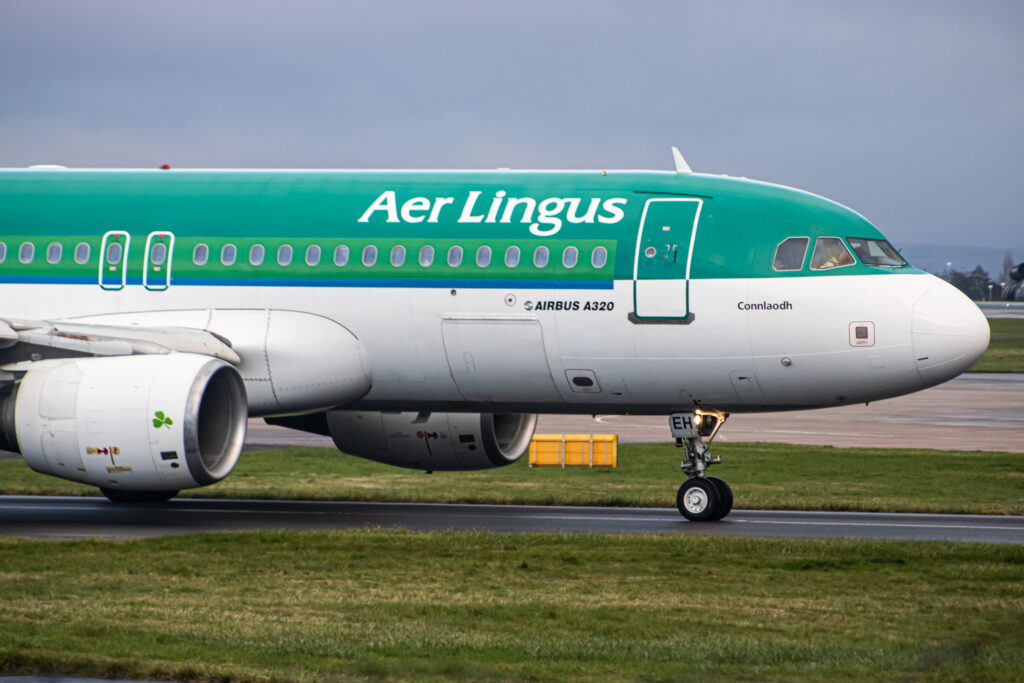As we celebrate St. Patrick’s Day, let’s take a look at a brief history of Ireland’s flagship carrier, Aer Lingus.
Join us on a journey through time as we delve into the history of Aer Lingus.
From its humble beginnings in 1936 as a small Irish airline to becoming a global player in the industry, this is a story that will captivate anyone with an interest in aviation or business.
So fasten your seatbelts and get ready for takeoff – we’re about to explore the fascinating history behind one of Ireland’s most iconic brands!
The Early Years

Aer Lingus was founded on 15 April 1936, with a capital of £100,000.
The company was established as a private enterprise by a group of Irish businessmen led by Dr. Tony Ryan, who invested £22,000 in the venture.
The Airline started operations on 27 May 1936 with a single de Havilland DH.84 Dragon aircraft named Iolar (Irish for ‘Eagle’).
The aircraft was captained by Jim Hennessy and took off from Baldonnel Aerodrome in Dublin, bound for Bristol Airport in the United Kingdom.
On its first day of operation, Aer Lingus carried 33 passengers and 3 tons of cargo on the flight from Dublin to Bristol.
The airline rapidly expanded its fleet and routes over the next few years, adding new routes to London and Manchester in 1937, Amsterdam and Paris in 1938, and Zurich and Geneva in 1939.
By the end of 1939, Aer Lingus operated a fleet of six Dragon aircraft on ten different routes across Europe.
[monsterinsights_popular_posts_inline]
The outbreak of World War II put Aer Lingus’ operations on hold as many of its routes were closed due to conflict or travel restrictions.
However, the airline resumed limited operations after the war ended in 1945.
In 1947, Aer Lingus became the first foreign airline to operate regularly scheduled services out of New York City’s Idlewild Airport (now JFK International Airport).
The Golden Age

The Golden Age is often considered to be the period between the two world wars when aviation was in its infancy, and aeronautical engineering was developing rapidly.
This was a time of great optimism for the airline industry, as it seemed that anything was possible. Aer Lingus was founded in 1936, during this exciting time for aviation.
The company quickly established itself as a leading player in the Irish aviation market.
Aer Lingus grew rapidly during the Golden Age, thanks to the increasing demand for air travel. The airline began operating flights to destinations all over Europe and beyond.
Aer Lingus also became known for its innovative marketing campaigns, which helped to attract more passengers.
One of the most famous examples is the “Irishairman” campaign, which featured a young man dressed in traditional Irish clothing flying an airplane.
The Golden Age came to an end with the outbreak of World War II. Although Aer Lingus continued to operate during the war, it was forced to make many changes in order to survive.
After the war ended, passenger numbers slowly began to recover, and Aer Lingus entered a new era of growth.
The Modern Era

In the past two decades, Aer Lingus has transformed itself from a state-owned enterprise into a successful international airline.
Following privatization in 2006, the company has undergone a dramatic turnaround, returning to profitability and becoming one of the most efficient airlines in Europe.
Under the leadership of CEO Stephen Kavanagh, who took over in 2014, Aer Lingus has embarked on an ambitious growth strategy focused on expanding its transatlantic network and building its presence as a leading low-cost carrier in Europe.
In 2015, Aer Lingus carried 11.6 million passengers and generated revenues of €2.3 billion.
The airline currently operates a fleet of 78 aircraft, including 22 A320neo family aircraft, and employs over 4,000 people.
The Future of Aer Lingus

The future of Aer Lingus is looking bright. The airline has been profitable for the past few years and has been investing in new aircraft.
In 2019, Aer Lingus took delivery of three new Airbus A321neo aircraft and will take delivery of two more in 2020.
The airline has also ordered 10 Airbus A350-900 aircraft, which are due to be delivered between 2023 and 2025.
Aer Lingus is also expanding its route network. In 2019, the airline launched new routes to Philadelphia, Minneapolis-St Paul, Pittsburgh, and Seattle.
It also started a codeshare agreement with Alaska Airlines, which gives passengers more choices when flying to the US West Coast.
Looking ahead, Aer Lingus is well-positioned to continue its growth and success.
Looking to the future, Aer Lingus is committed to providing its passengers with a safe, comfortable, and efficient flying experience.
The airline will continue to invest in its fleet and infrastructure, with a particular focus on digital transformation.
This will enable Aer Lingus to provide an enhanced customer experience both on the ground and in the air.
In addition, the airline will continue to grow its route network, offering more choice and flexibility for passengers.









